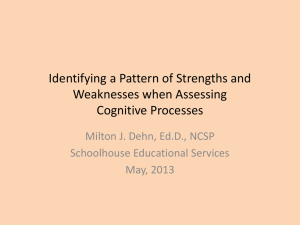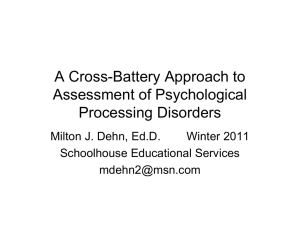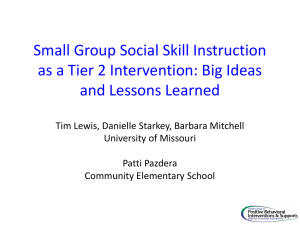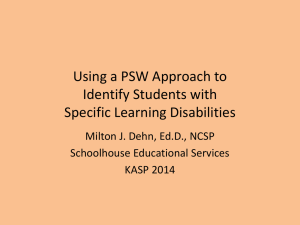Dehn Minds handout
advertisement
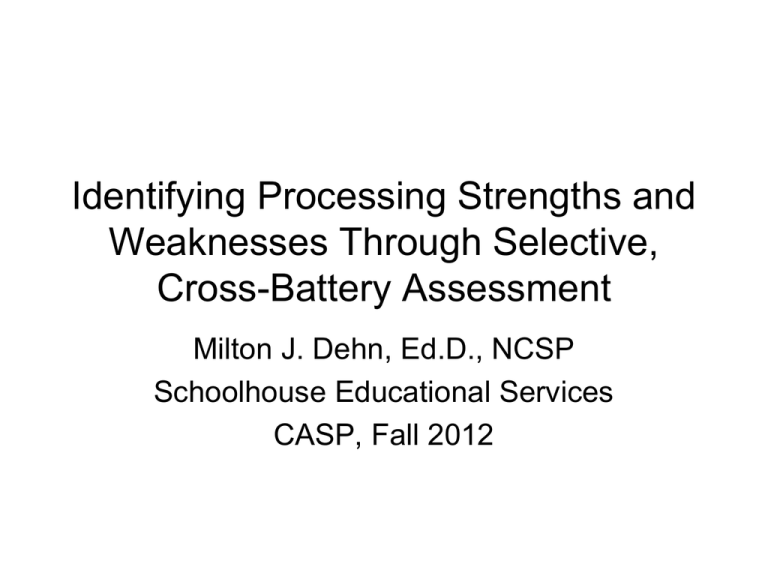
Identifying Processing Strengths and Weaknesses Through Selective, Cross-Battery Assessment Milton J. Dehn, Ed.D., NCSP Schoolhouse Educational Services CASP, Fall 2012 Notice of Copyright 2012 This PowerPoint presentation and accompanying materials are copyrighted by Schoolhouse Educational Services, LLC and Milton J. Dehn. They are not to be reprinted, copied, or electronically disseminated without written permission. To obtain permission, email milt@psychprocesses.com Workshop Topics 1. 2. 3. 4. 5. 6. Overview of psychological processing Processes to assess Processes and academic skills Selective, cross-battery testing Identifying strengths and weaknesses Case study What are psychological processes? 1. Brain processes, operations, functions 2. Any time mental contents are operated on 3. When information is perceived, transformed, manipulated, stored, retrieved, expressed 4. Whenever we think, reason, problem-solve 5. Can’t learn and perform without processing 6. Learning depends on these processes 7. Doesn’t include knowledge or academic skills Human Processing Limitations 1. Human limitations Problems with Past Processing Assessment 1. 2. 3. 4. 5. 6. Not enough known about processing Not sure how to test processing Assessment too informal; too narrow Did not include higher level processes Memory seldom assessed Controversies over the value of processing assessment 7. Some ineffective interventions, e.g. perceptual-motor Improvements in Processing Assessment and Intervention 1. More and better processing tests 2. Neuroscience and neuropsychological evidence on brain and learning 3. Neuropsychological influence on assessment (what underlies the learning problems) 4. Research on processing, memory, academics 5. More assessment of memory 6. Updated & new research on interventions 7. New interventions What Have We Learned 1. More about the processes needed for academic learning 2. The specific areas of the brain involved in childhood disorders 3. Childhood disorders, including SLD’s have a neurobiological basis 4. Interventions should be evidence-based 5. The discrepancy model did not work well for LD identification Processing Assessment Advantages 1. Benefits the learner: understanding why 2. Identifying a processing deficit differentiates SLD & slow learning 3. Ethnic and racial differences less than IQ 4. Interventions for processing deficits 5. Identifying processing deficits provides direction for academic interventions The Need for More Processing Assessment 1. Part of a neuropsychological approach 2. Not just for LD; e.g. executive for ADHD 3. Brain-related assessment needed more because more children have medical conditions; e.g. head trauma 4. Private practitioners often don’t connect with school environment needs and criteria Processing and RTI 1. Processing model consistent with problemsolving and early intervention 2. Processing assessment has changed 3. Now, evidence-based processing interventions 4. Different processing “causes” of SLD 5. Why do “blind” general academic interventions 6. Processing & acad. interventions compatible 7. Which academic interventions succeed? 1. Those that address processing problems “Resistance” to Intervention • Successful achievement depends on adequate psychological processes • Processing deficits impair learning • A processing deficit can cause an academic intervention to fail – When severe – When not addressed Characteristics of Psychological Processes to Assess 1. 2. 3. 4. 5. Brain-based Interrelated Necessary for academic learning Broad and narrow processes Related behaviors observable in classroom Brain Lobes and Processes • Frontal Lobes: Attention, Executive Functions, Working Memory • Temporal Lobes: Long-Term Memory, Auditory Processing, Short-Term Memory • Parietal Lobes: Fine motor, Working Memory, Auditory, Phonological, • Occipital Lobes: Visual-spatial processing Dehn’s Recommended Processes for SLD Assessment 1. Attention 2. Auditory Processing 3. Executive Functions 4. Fine Motor 5. Fluid Reasoning 6. Long-Term Recall 7. Oral Language 8. Phonological Processing 9. Processing Speed 10. Visual-Spatial Processing 11. Working Memory Attention 1. Necessary for learning and memory 2. Attention deficits part of LD; not necessarily ADHD 3. Types: Selective, focused, divided, sustained 4. The problem is attentional control & lack of inhibition 5. Related to Executive Functions and Working Memory Auditory Processing 1. Ability to perceive, analyze, synthesize, and discriminate auditory stimuli, mainly speech 2. Perceiving and comprehending instruction; being able to understand words with background noise Executive Functions 1. Management of cognitive functions and psychological processes 2. Effectiveness depends on self-monitoring, selfregulation, and metacognition 3. Has a longer course of development 4. More to do with classroom performance than learning of academic skills Fluid Reasoning 1. Deductive, inductive reasoning, especially with novel materials 2. Has a longer course of development 3. More important for applied academics Long-Term Recall 1. Close connection with other processes and with academic learning in general 2. Includes encoding, consolidation, storage, and retrieval 3. Rapid automatic naming is part of Oral Language 1. Not the content (vocabulary) or receptive language but the oral expression processes Phonological Processing 1. Processing of phonemes, e.g. blending 2. Phonemic awareness is part of Processing Speed 1. How quickly information flows through the processing system; a matter of efficiency 2. Too slow: info. lost, process not completed Visual-Spatial Processing 1. The ability to perceive, analyze, synthesize, manipulate and think with visual patterns 2. A strength in most LD cases 3. Weak relations with all academics; more of a “threshold” process Working Memory 1. Processing while retaining information 2. Includes short-term memory 3. Both verbal and visual Processes and Academic Learning 1. Psychological processes are like “aptitudes” 2. Relations established through research 1. Flanagan et al., & McGrew 2. Swanson, Geary, and others 3. The influence of processes varies by age 4. Look for academic area and related psychological processes to both be low 5. See Table Research: SLD by Processing Subtypes 1. Visual-Spatial Deficits: Math calculation and math problem solving 2. Processing Speed Deficits: Reading comprehension, written expression 3. Working Memory Deficit: Math calculation, Written expression 4. Attention: Written expression Source: Hain, Hale, Kendorski Highest Influence of Processes on Academics by Grade • Early elementary: Phonological, visual, auditory, rapid automatic naming, STM, sequencing, fine motor control • Late elementary and beyond: Executive, working memory, long-term memory • All grades: Processing speed, attention, oral expression Processing Assessment Challenges 1. 2. 3. 4. 5. 6. 7. Connecting to academic concerns Interrelated processes Informal methods lack validity Not found in one convenient battery Doing it efficiently Having enough expertise Linking with interventions Processing Assessment 1. Should be multimethod/multisource 2. Multi-settings 3. Formal and informal 1. Qualitative not enough 4. 5. 6. 7. 8. Should include standardized testing Should be hypothesis driven (suspected) Based on referral concerns Selective, cross-battery testing Integrate data during interpretation Records Review 1. 2. 3. 4. Any medical or health conditions Age of onset Developmental delays Look for indications of same behaviors that could be observed 1. Difficulty memorizing arithmetic facts could be a working memory deficit 2. Difficulty blending could be phonological proc. 3. Low fluency could be processing speed problem Interviews 1. From middle school up, do interviews 1. E.g., “Do you often forget what was just said?” 2. Teachers: Ask about observable behaviors, then ask their hypotheses 3. With parents, use home environment examples 1. “Does your child have difficulty rhyming?” See examples Observations 1. Some processes more observable than others, e.g. memory is more observable 2. There’s no one-to-one correspondence between a behavior and a process 3. Each behavior depends on multiple processes; try to narrow it down 1. E.g., poor organization could be due several See examples 4. See memory examples Selective, Cross-Battery Testing 1. Assess areas based on concerns, not on what a test has to offer 2. Mix tests/batteries to cover all the areas 1. Limit to 2 or 3 batteries 2. Should be normed about the same time 3. Avoid redundancies 4. Ideally, 2 subtests per process 5. Analyze results together by computing a cross-battery mean Dehn’s Approach to Cross Battery 1. Not limited to CHC factors 2. “Narrow” abilities/processes included 3. Includes processing factors that are important for learning of academic skills 4. Analyze scores at the factor (twosubtest) level whenever possible 5. Use a hand computation analysis sheet or the Psychological Process. Analyzer Hypothesis Testing Approach 1. Collect preliminary data 1. Records review, observation, interview 2. Identify referral concerns 3. Generate processing hypotheses (suspected processing problems) 4. Select assessment methods 1. Cover all hypotheses 2. Avoid redundancies Selective Testing 1. All processes important for academic learning should be tested 2. With most attention, in-depth assessment of hypothesized weaknesses 3. Apply a cross-battery approach 4. See selective testing table for cog. & ach. Link Cross-Battery Analysis of Scores 1. See Processing Analysis Worksheet 2. Get factor scores from test manual when possible 3. Exclude non-processing factors and subtests 4. Compute clinical factor scores by averaging 1. First convert scaled scores to 100/15 metric 5. 6. 7. 8. Compute processing mean Calculate difference scores Determine weaknesses and deficits Do pairwise comparisons 1. Opposites and those closely related Identifying Strengths and Weaknesses 1. These are intra-individual strengths and weaknesses 1. At least a 12 point standard score difference from the mean of processing scores 2. As opposed to normative weaknesses 1. Below average score (below 90) 3. For diagnosis, should be both an intraindividual weakness and a normative weakness 4. When it’s both, Dehn refers to as “deficit” Deficits and Disabilities 1. 2. 3. 4. Deficits (double weakness) are rare They have an underlying neurological basis They impair learning Students with below average IQ are less likely to have 5. Deficits more predictive of need for LD than an ipsative or normative weakness alone. 6. Below average processing (normative weakness) still impacts learning and benefits from intervention Research Example of Deficit 1. 74 students evaluated for learning problems 2. 42% of disabled/discrepant group (but not in LD) had a normative but not an ipsative weakness in Executive WM compared to 6.5% of normal group 3. 43% of those placed in LD had both a normative and ipsative weakness in Executive WM compared to only 4.3% of normal group 4. Deficit (double weakness) more predictive of need for LD Case Study: “Jacob” 1. 2. 3. 4. 5. 6. 7. 8. Age 13; 7th grade Foster care; special ed placement 3 months premature; failure to thrive Early elementary IQ of 70; recent IQ of 95 ADHD diagnosis; poor organization Social skills problems Difficulty completing homework Moderately high test anxiety Case Study Continued 1. 2. 3. 4. 5. 6. 7. Likes to read Struggles with Math and Written Lang. Reading Composite – 106 Math Composite – 88 Wr. Lang. Composite – 73 Oral Lang Composite - 87 List your processing hypotheses to account for low achievement and background factors Case Study Continued Reveiw Jacob’s Proc. Analysis Worksheet What are his processing deficits? What are his processing strengths? Do his processing deficits link to his low achievement areas? 5. Does his processing profile explain his learning difficulties? 6. Does he qualify for SLD in processing? 7. What else should be tested? Link 1. 2. 3. 4. Support for Strengths and Weaknesses 1. Informal data supports test scores and results of score analysis 2. Corroboration especially needed when scores differences are less than one standard deviation (12-14 points) 3. Integrate data when writing report 4. They match with specific academic areas they are highly related to Evidence for a Processing Disorder and SLD Diagnosis 1. It’s not specific to one environment 2. A normative weakness (below average score) 3. Intra-individual: score is significantly weaker than predicted from discrepancy analysis 4. Best if it’s an intra-individual weakness and a normative weakness (this is a deficit) 5. It’s impairing academic learning 6. The low psychological processes and low academics have research-based links 7. The linked process and academic skills both have low scores (consistency approach) 8. Non-LD also have strengths and weaknesses Consistency Approach • With processing, use a consistency approach, not a discrepancy approach – Low process + low academic skill = SLD – NOT high process + low academic skill Diversity/Equity Issues 1. Less culturally loaded (e.g. verbal) processing tests have fewer differences between racial, ethnic, SES groups 2. K-ABC, a processing type of IQ test has minimal differences 3. Ortiz et al. low cultural loading: Visual, Processing Speed, Retrieval, Fluid Reasoning, Working Memory 4. Rating scales: Executive, Attention Psychological Processing Analyzer 1. Available at www.psychprocesses.com 2. Identifies strengths and weaknesses 3. Conducts cross-battery analysis using composites and/or subtest standard scores 4. 11 psychological processes 5. From 22 different scales: cognitive, achieve., rating, and processing (list) Psychological Processing Analyzer 1. Composite and subtests are limited to those that are fairly direct measures 2. Some are re-classified based on the primary demands of the task; example 3. Difference formulas based on reliability coefficients of composites/subtests 4. Regression toward the mean 5. .01 or .05 level of significance Psychological Processing Analyzer 1. All scores converted to standard scores 2. Non-unitary process scores are flagged 3. Predicted score for each processes based on mean of other 10 4. Differences greater than critical values are intra-individual weaknesses 5. Deficits are both types of weaknesses 6. Pairwise comparisons are optional PPA Case Study Struggling 2nd year college student Significant problems with math Intensive tutoring in past Indications of memory problems Family history of LD Administered WJ III COG., WMS-IV, and parts of WAIS-IV 7. See results 1. 2. 3. 4. 5. 6. Rating Scales: Children’s Psychological Processes Scale (CPPS) 1. 2. 3. 4. 5. 6. 7. Standardized teacher rating scale Ages 5-0-0 to 12-11-30 121 items across 11 subscales Internet, web-based test Administration time of 15 minutes Online scoring and report Author: Milton Dehn; published by Schoolhouse Educational Services, 2012 8. Measurement Consultant: Kevin McGrew Uses of the CPPS 1. LD Evaluations 1. 2. 3. 4. Identify psych processing deficits Pattern of strengths and weaknesses Planning further assessment Planning interventions 2. Screening 1. Identifies need for intervention 2. Predicts academic skills development 3. Useful in planning comprehensive assessment 3. Measure progress during interventions 1. Through the use of change-sensitive W-scores CPPS Items • Grouped by subscale • In developmental (ability) order from lowest item to highest item • Link Conclusions About Processing Assessment • It can be done well but there are challenges • Professional judgment is necessary • Selective, cross-battery testing necessary • Test the processes associated with the academic deficiency • Use the consistency approach • Explain the link Selecting and Planning Processing Interventions • • • • Based on data and assessment findings Individualize based on profile Select processes related to academic concern Take individual’s abilities and cognitive load of task into consideration---don’t overload WM • Interventions are not necessarily processing specific but rather academic that match with the processing problems; e.g. phonics-based reading for a phonological deficit Interventions for Processing Weaknesses & Deficits, in General 1. 2. 3. 4. Strengthen weakness if possible Utilize the strong areas more Or do both Modifications that reduce the need to use the weak processes 5. Use methods that involve other processes, more of the brain Processes with Best EvidenceBased Interventions 1. 2. 3. 4. 5. 6. 7. Attention Auditory Processing Executive Functions; Planning Long-Term Recall Oral Language Phonological Processing Working Memory
